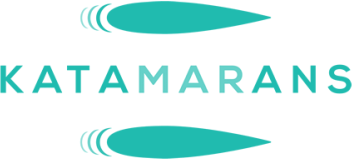Windelo 50
10 minutes readWindelo 50 Owner’s Review
Many thanks to the owner’s of the first Windelo 50: “Hakuna Matata” for this owner’s review.
There are some great responses in this one, very comprehensive.
At the end of the interview, you will find an update on their Atlantic crossing with some information on diesel usage.
Can you tell us a bit about yourself and your Windelo 50? What is your plan?
Long distance cruising or weekend sailing?
After 10 years of chartering – on average 2 to 5 weeks a year along the Brittany and Mediterranean coasts – the time has come for us as a family to set sail for a 8-months North Atlantic tour.
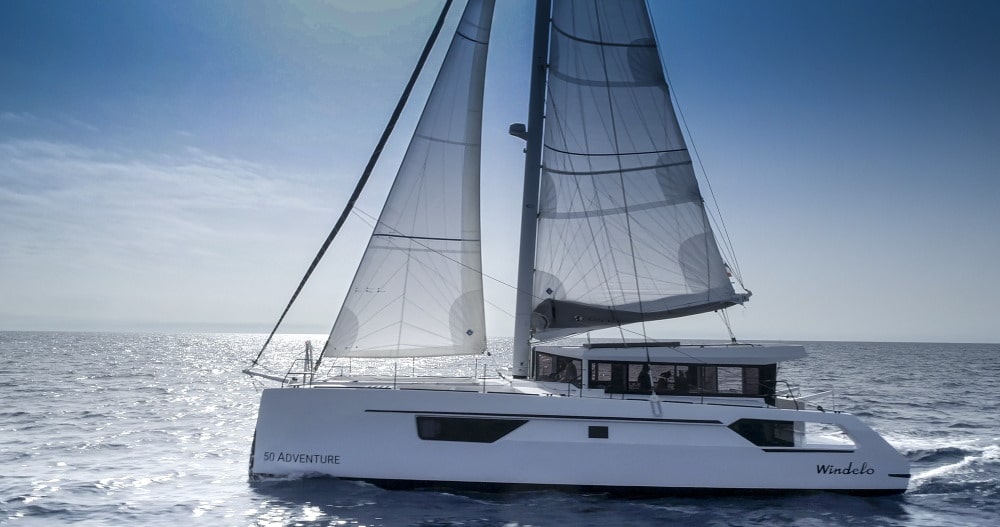
Why did you choose the Windelo 50? Was there one thing overall that convinced you to purchase a 50?
I’m generally passionate about design and innovation which is exactly how Windelo created the boat. By pioneering new concepts, Windelo have created a boat that is unique in terms of combining great sailing performance and quality of life aboard for the whole family.
As an entrepreneur, it was also added interest for me to sponsor the development of a new brand.
When was she launched? How was the purchase and build process?
Hakuna Matata was launched Febuary 26th, and the team did a fantastic job to get her completed and launched amongst all the Covid-19 experience.
What’s the best thing about her?
I love that she takes off in very light winds, and that in normal conditions we travel faster and higher than before. Plus we all enjoy her open plan which is a fantastic platform when we’re in a nice bay enjoying swimming, dinner, etc.
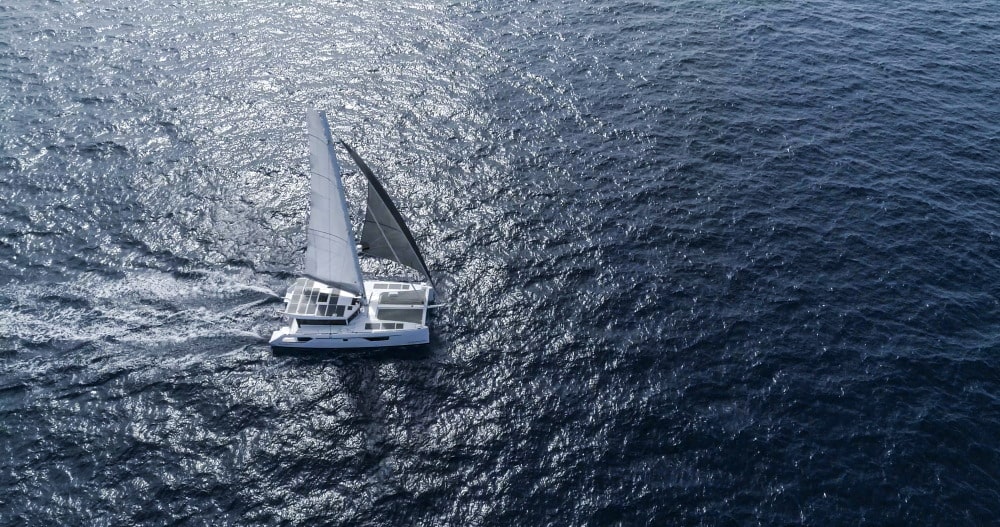
What would you change if anything on the design? Maybe you wouldn´t change anything?
Well, I’ve ordered a Windelo 54 as the next upgrade so the design works for me. The only thing we re-worked with the yard was of the cockpit upholstery which is now way more comfortable !
Does she carry weight well, or do you have to be careful to not overload her with gear?
So she’s 12.2T herself, and 14.6T with all tanks full, spares on board, our nice tender with steering console & 20CV engine, galley equipment etc. etc.
That leaves us a full 2T to carry, of which 8 crew and their kit would be about 0,5T. That’s the most people we’ll have on board so I should think we’ll always be around 1.5T below the max payload.
Since the weight distribution itself is very low and central at the mast/cockpit, the center of gravity is always well placed regardless how much you load up the various lockers.
What are the “Must Have” Options buying new in your opinion? eg sail options, water-maker, generator, solar options, carbon options etc
From an electric standpoint it makes sense to get the right amount of solar panels for your equipment and life aboard. And when you do so, because the boat is so good at managing power, the induction cooking hob and electric oven are a must have.
In terms of rigging and sails, the code 0 makes a lot of sense and for our Atlantic crossing I also chose to board a 160m² Gennaker.
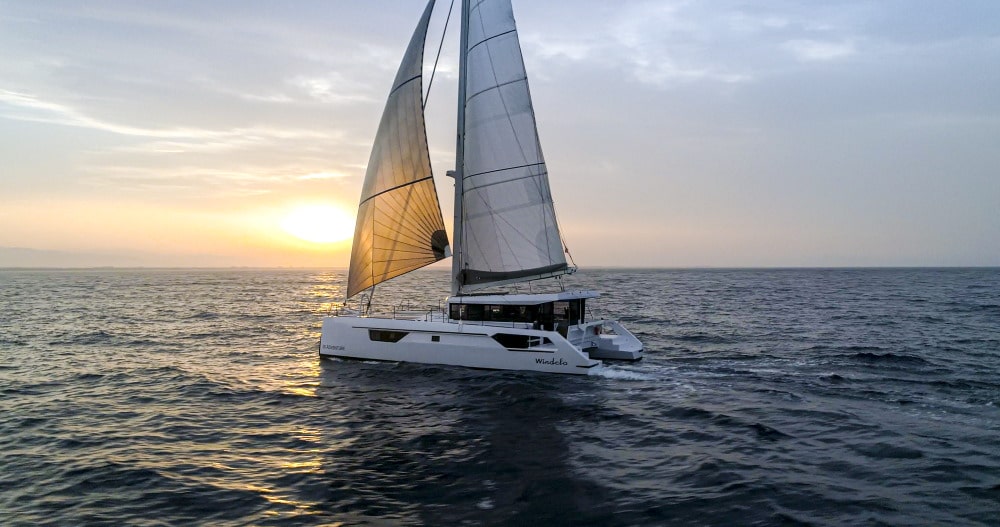
Does your catamaran have daggerboards or high-performance fixed fin keels?
She has dagger-boards, which are absolutely vertical and used symmetrically (no adjustment at every tack).
They are located centrally in the hulls which is where they are most efficient, yet very nicely integrated down below. Many people don’t notice them in the cabins.
How have you configured the saloon and cabins?
Hakuna Matata is a 3 cabin owner boat, but with some specifics. The forward port cabin is made into a full size study with a fold-out bed nonetheless. And the forward starboard cabin is a children’s bunk bed layout with bookshelves and a desk for their homework.
Both aft cabins have double beds, one of them is a even a full queen size… We’re very pleased with this layout which gives us a nice feeling of being in our own home.
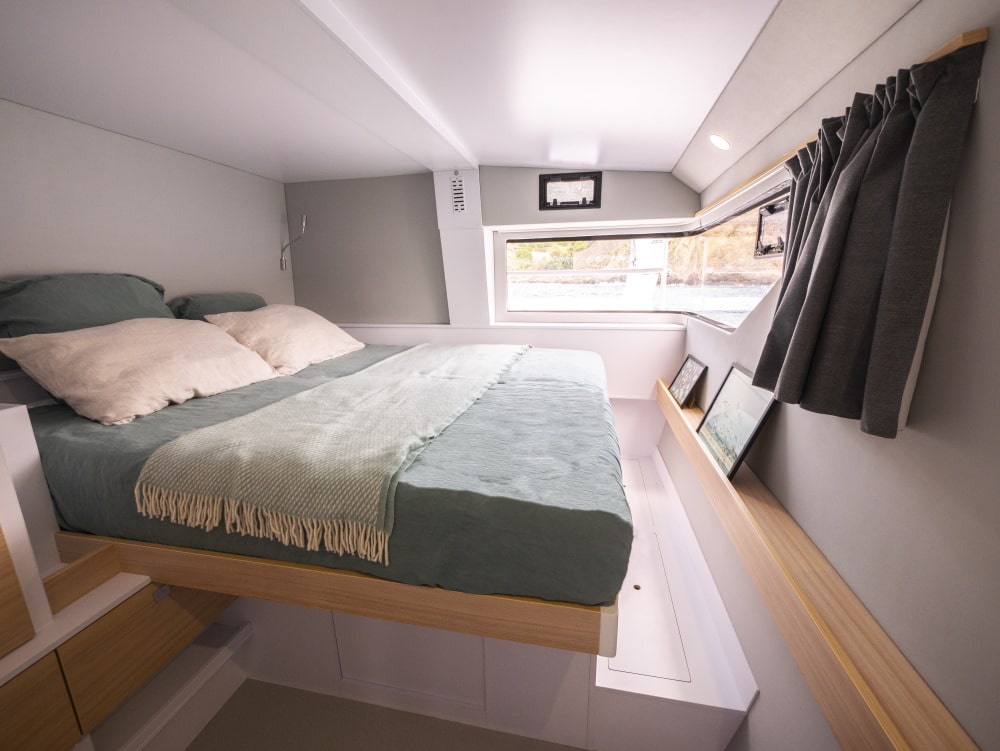
What are the “Nice to Have Options”?
I will say I went for the carbon mast which removes a bit of weight from the boat but is also aesthetically pleasing. I hope that’s recognised also in terms of resale potential later on.
We added a sunbed on the roof and you could get more also for the front of the boat.
Every option is per say nice to have… I found that the yard will really advise you based on your schedule, your family and the size of the boat as to what really makes sense for you.
Which options did you skip?
Personally I skipped the Hi-Fi sound system installation. With full 220V supply we can bring our own Bluetooth speakers or even our existing Hi-Fi system from home.
How have you set up the power system? How much solar, hydro, wind, generator back up etc. Is this sufficient for your power needs?
Even though we have a sunbed on the roof we still have 3500W of solar power which is ample to provide for live on board by itself. We usually have power left over to provide to the engine battery packs.
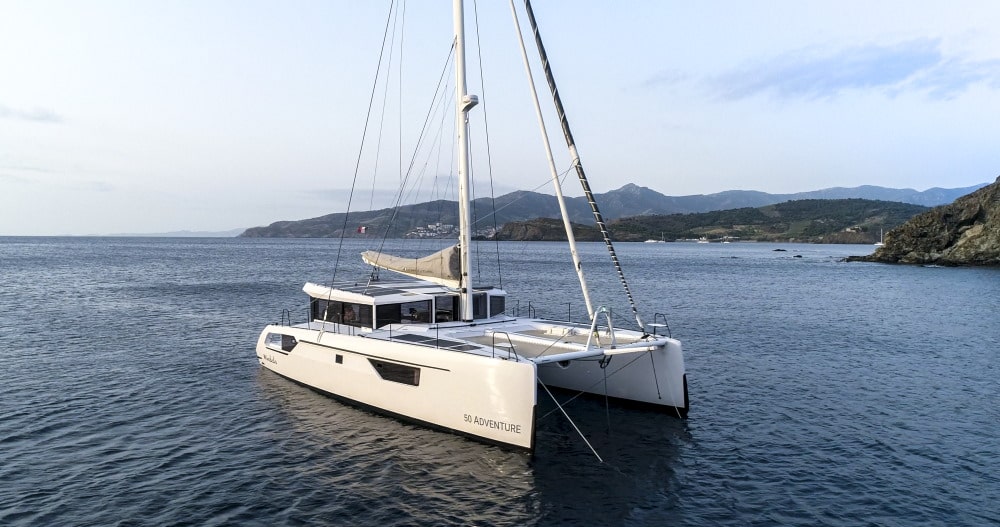
Is she easy to maintain? Servicing engines, standing rigging etc
I haven’t gone through any maintenance myself yet as she’s been based at Windelo. But I do know that the new Bellmarine engines that have been fitted don’t have any belts and only need a checkup every two years.
Is she easy to sail short-handed? To shorten sail? Is the running rigging complex? Do all the lines lead to the helms?
All the lines come back inside the cockpit. Only the Gennaker/Code 0 halyard and reefing hooks are at the mast, but then the mast is only one step up from the cockpit. So essentially you can say everything is done from the cockpit – it really feels protected and safe.
My boys and wife like to take part in the sailing most of the time, but on night shifts it is often the case that one of us operates the boat alone and it’s never been a problem. I know the guys from the yard have delivered her single-handed too.
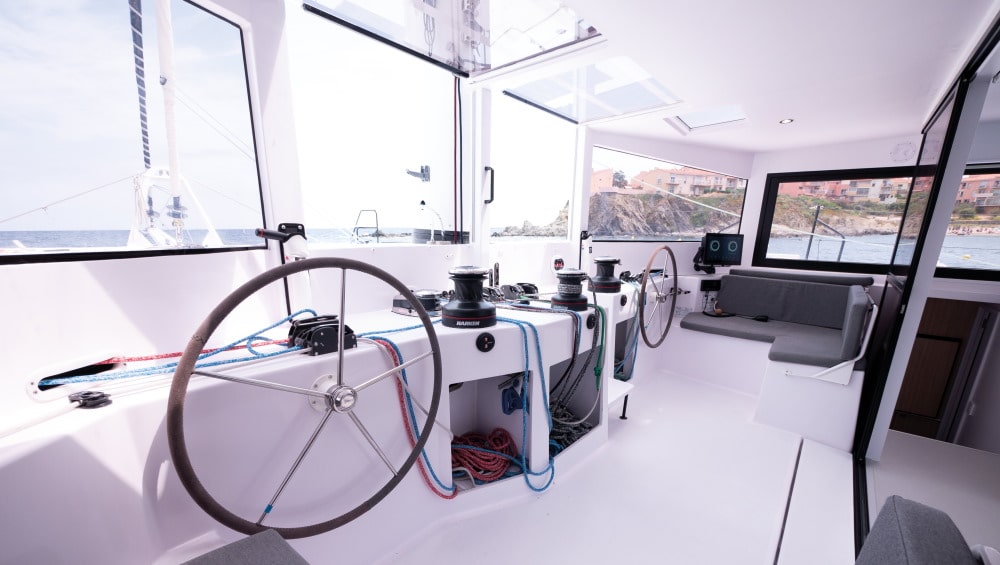
What’s she like in heavy weather / a blow / big seas
Well there are a couple of ways she’s different. Firstly she is very sea-worthy. Her thin bows cut into the water rather than smash into it so there is no additional wash created. Then the long trampoline disperses any remaining wash.
She is so high above the water that if any water ever reaches the cockpit it is merely a splash on the windows.
Secondly even if it does get wet outside, within the cockpit you can stay dry and warm, and feel very safe.
How are the forward helm positions? Good in weather? How is the visibility when docking?
As I mentioned just before, yes the cockpit is a very safe environment in heavy and wet conditions. However, when you feel like it or in lighter conditions you’ll probably have the cockpit open. Then it is quite surprising how well you can feel the airflow through the boat, you actually feel the gusts and the lulls just as if you were on the top of a flybridge. So you actually do have that feel for the environment and changing conditions, which is important to us sailors.
How does she sail in light winds?
Sailing on board the Windelo 50 is extremely nice. It’s a boat that accelerates well, is fast in light winds, and very stable on the water. It rises exceptionally well in the wind, and this was a huge surprise for me, as I’ve never had the opportunity to sail with retracting daggerboards. Really very enjoyable.
How does she sail close hauled? How high does she point to true?
She sails nicely at 45° to the TWA. And tacking upwind is easy with he self-tacking yet big solent. She sails and tacks easily in 3 knots of true wind.
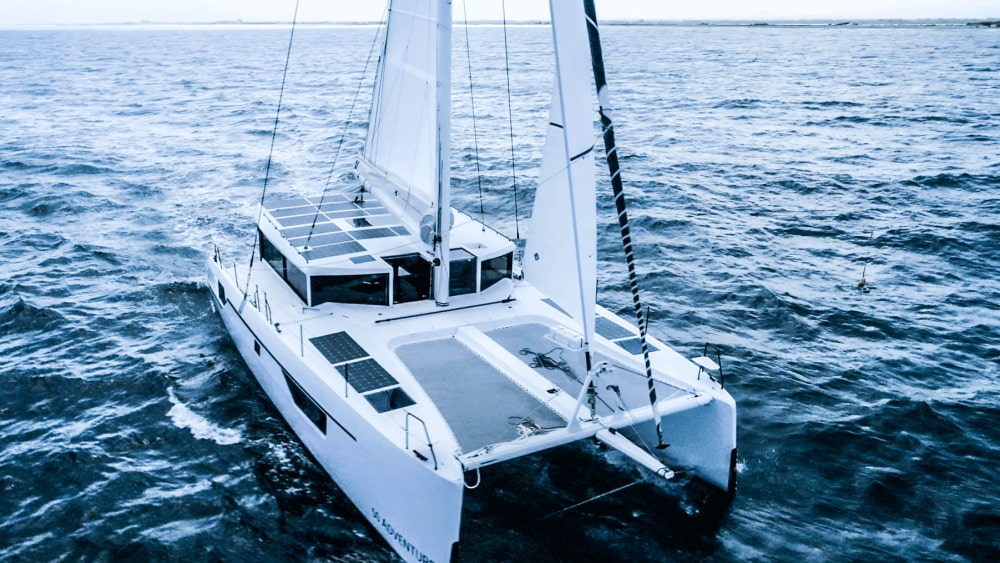
Typically, what’s your average speed on passage? What´s the top speed you have logged surfing? At what TWS do you start sailing?
In force 3 to 5 which is where we typically like to sail most days we’ll consistently travel at 9,10,11 knots without too much trimming. But it is possible to push her more, and for instance in stronger conditions we regularly sail 13, 14, 15 knots.
To answer your question, so far my top speed is 19.2 knots off Mallorca. But we’ll be sailing for the next few months so stay tuned 😉.
What’s she like under power? Speed, manouevrability?
With her light displacement in harbours she actually starts and stops surprisingly easily with very little engine power applied. But if you need it, electric engines provide a lot of torque so you can stop the boat or accelerate out of someone’s way very easily.
Is she easy to dock, what’s the visibility like?
Visibility upfront is remarkable. And the crew stay in touch easily, then can go in and out of the cockpit from the front which creates a lot of fluidity in our coordination. It’s true a weak point is one small dead angle from the helm towards the aft staboard quarter.
Windelo are opening up this angle and of course if you’re into tech there is a back-up camera. We find that we manage without just fine but it’s there if we need it.
What is she like at anchor?
There’s very smooth to and fro between galley and dining room, and the aft deck completely open to the water is a real bonus.
What’s she like when it´s raining hard?
When it’s raining you can still go sailing… in your socks.
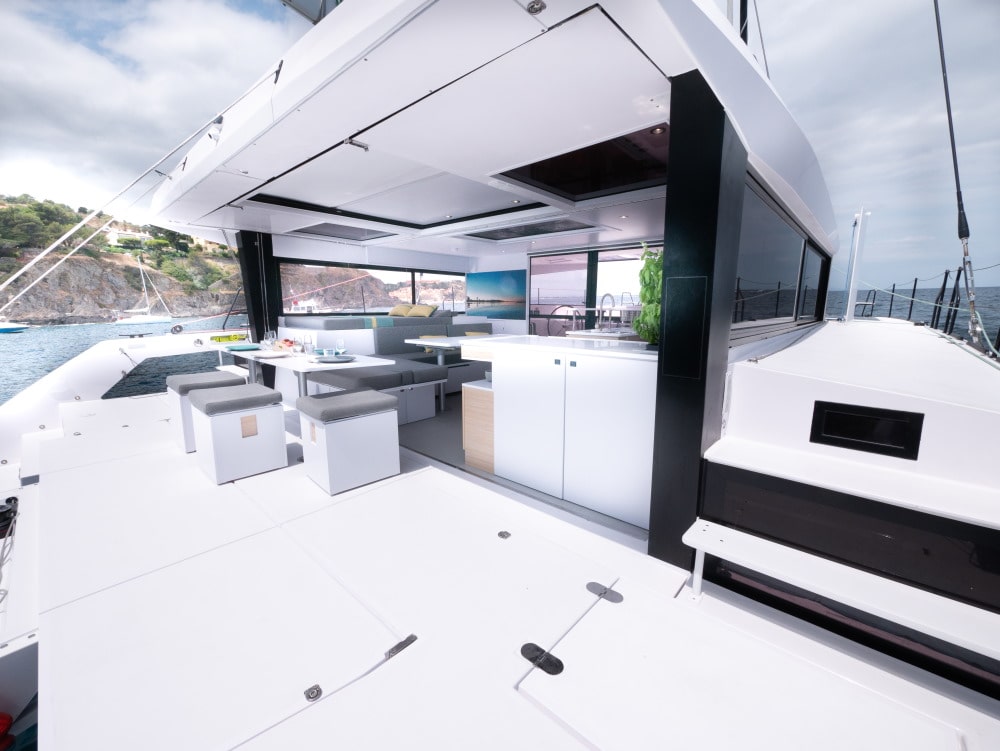
Is she comfortable down below? Cabins/saloon/galley/heads.
I’m a tall guy so for me (and I know for the Windelo family too), headroom was important. The amount of space down below is impressive, and all the living areas are very bright with natural daylight pouring in.
How is the finish of the interior? Does she creak under sail?
In terms of the structure, that’s one of the most impressive aspects of this boat. Let’s remember is a number one : not a single creak or noise underway – other than the flow of water against the hulls. This speaks for a strong design and high build quality of the structure itself and is probably the most important part.
I’ll be honest, the finishes of the interior weren’t quite where they needed to be initially. But we did some rework with the yard and it does meet expectations for an Adventure version. Windelo themselves have put this as the priority for the next boats, and I’m confident that when they make this a focus they can be as good on finishes as they have been on the structure. No doubt the next boats will be right first time!
What is important is that all along the way and whatever the subject they were open to feedback and rework, which is bound to happen on a number one. What counts here is the dynamic and the spirit of continuous improvement with which Gautier and his teams approach any problem.
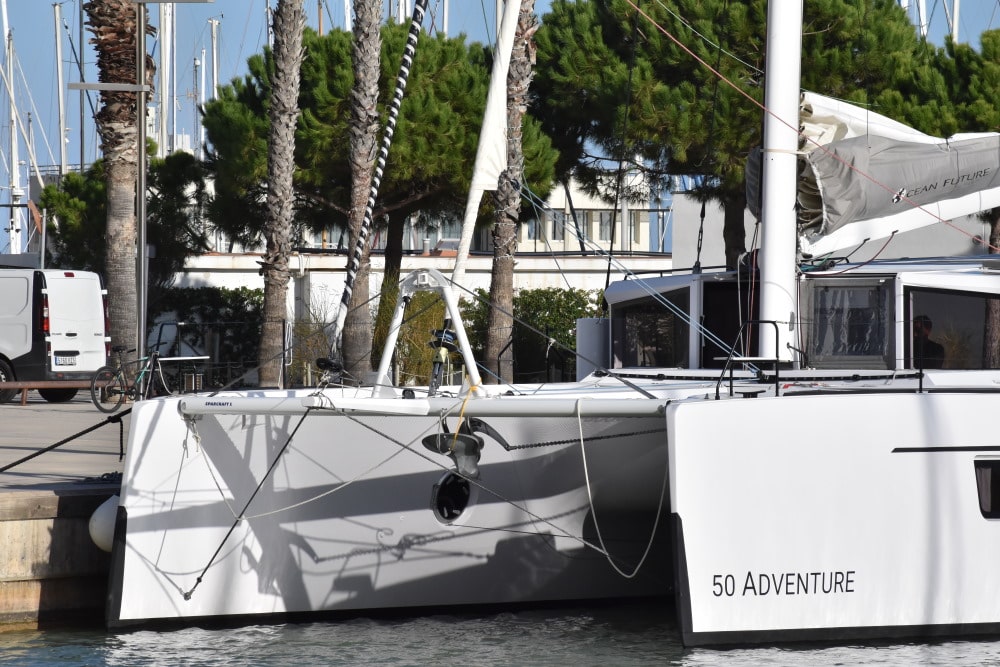
What is your favourite spot on the boat?
The forward cockpit is a key feature. We’re close to the center of gravity; it’s crazy! Now that I’ve had a taste of it, I couldn’t bear to sail a catamaran with an outside aft cockpit. In this forward cockpit, you’re well protected from spray and wind when it’s closed. And then, in calmer weather, you can open up and enjoy sailing from the outside. At the same time, because you’re open to the living quarters, you can socialize with everyone on board, the crew, and the others.
I appreciate the comfort when I’m at the helm. The Windelo is a real sailor’s boat, with particular attention given to the comfort of the crew when sailing. There’s a lot of socializing between the cockpit and the living quarters, so you can keep an eye on navigation without being cut off from life on board and the crew.
Those who aren’t navigating have nice comfortable spaces, in the living quarters, for example, with the quarter-berth or on the trampolines to enjoy the sunshine.
Perhaps I shouldn’t say this, but whether day in rough conditions or at night there is no more talk of lifejackets and strapping on. Everyone – including younger kids – is safe in the cockpit, in all conditions.
Is she good for hosting guests?
We have friends across the Mediterranean and in the US. We have already hosted brunches and dinners on board and will continue to do so as we visit our USA friends. The outdoor table seats 8-10 people.
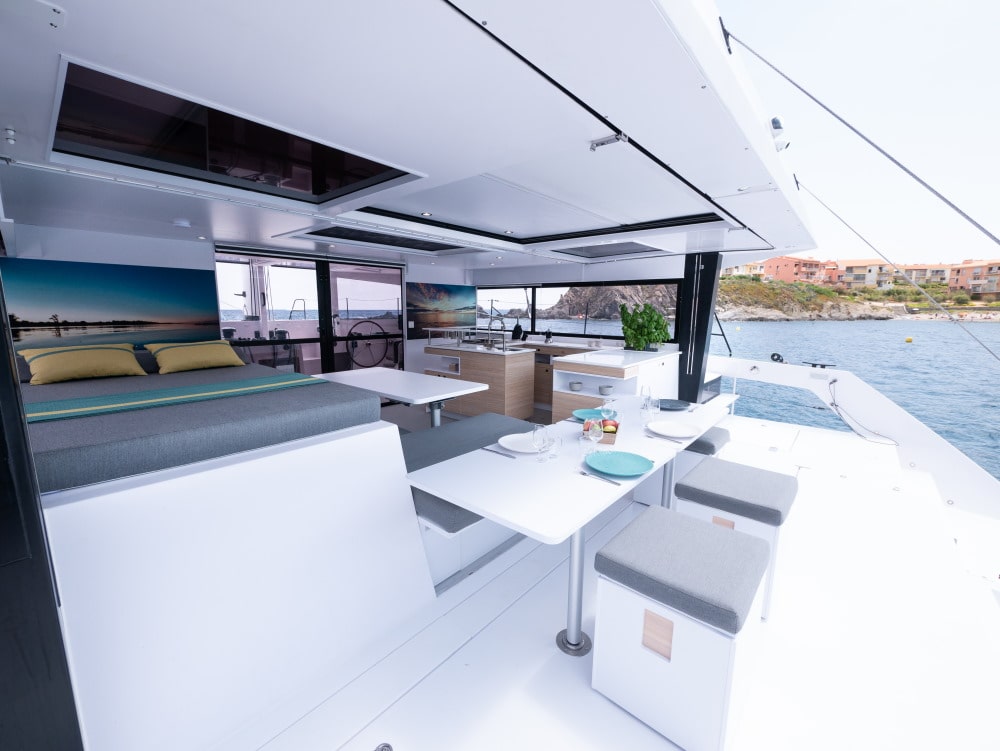
What kind of modifications have you done and why?
I followed the teams advice in fitting a 2nd 48V battery pack to power the engines – and I will say it made sense.
Any plans for further customisation?
The yard kitted out the boat for the ARC just recently. I think that’s the end of our customisation, and now we’ll be working on the interior design for our Windelo 54.
If you were to swap her for another boat, what would that be? Or maybe you wouldn’t swap her?
If anything, another Windelo.
How is the after sales service from Windelo?
Obviously with one boat on the water it is not yet an industrial after sales service with service tickets etc. Personally my boat was based in Canet on the yard’s doorstep which made things very fluid and in-person.
Right now I’m in touch with the yard through Iridium – at the moment just to keep them updated on our progress towards the Canaries.
On top of that I know that Windelo can remotely monitor the Boat Management System and Engines whenever there’s a 4G network.
Anything else you would add to help people thinking of buying a Windelo 50?
There’s something for everyone in the family to like. Because so many of the concepts are new but also customisable, its worth viewing the boat with the family and going through the personalisation process with the sales team.
But if you want to get a first idea, I hear they also just put their configurator online.
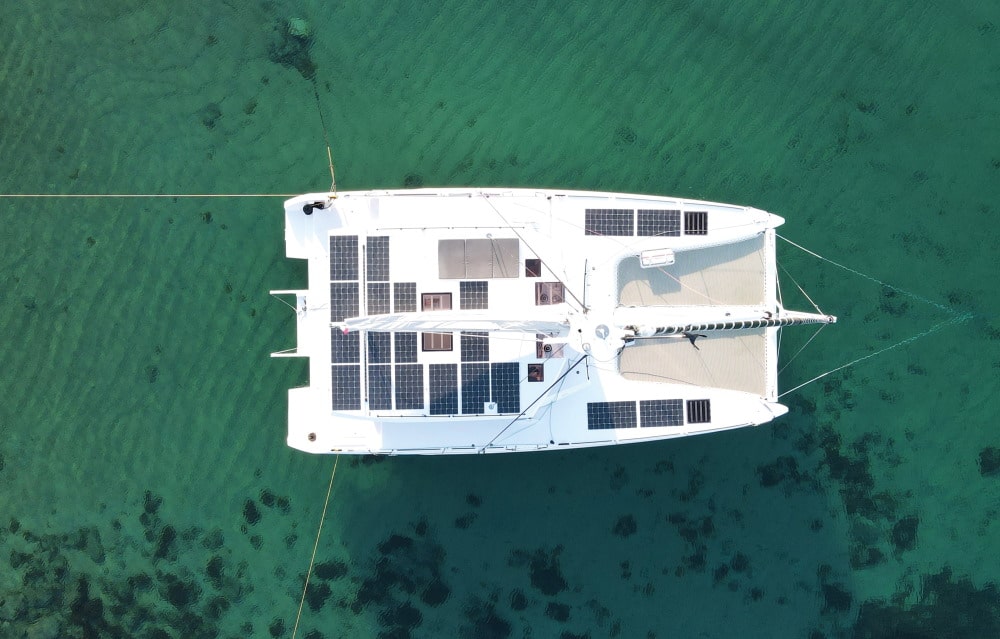
Finally, what are your favourite 3 things about the Windelo 50
Well, we’ve talked a lot about the cockpit and the living spaces. That’s two of them. But I also like the fact that this boat comes out of the yard with significantly less CO2 footprint from the Basalt and PET structure, and innovates in the electric/hybrid propulsion very well.
This is – to my knowledge – the first sailing catamaran with a true full electric and hybrid integrated setup that has proven to work. I’m glad to be able to be the first owner of such a pioneering boat, and I’d encourage any sailor looking in this category and sensitive to environmental matters down the Windelo path.
Update
In 2022, Hakuna Mata completed a double Atlantic crossing (there and back).
In eight months, they used only 800 litres of diesel, which includes the heating during the period spent in colder sailing zones.
The yacht left Canet-en-Roussillon on 17 October 2021, and is the first Windelo to have crossed the Atlantic (south route out, northern route back).
With more than 20,000 nautical miles and a 10-month Atlantic cruise under her belt, she proves that a transition to efficient, high-performance, eco-friendly sailing is possible for the nautical industry and positions Windelo at the forefront of this market segment.
The eco-composite structure (basalt fiber and PET foam), the electric engine, and the production of green energy (solar, hydro) have been thoroughly tested.
What was the most memorable part of the journey?
The Atlantic crossing between Canada and Iceland.
“We had really bad weather and sailing conditions, with a cross sea and pyramid shaped waves, seven to eight meters high! The forward cockpit proved itself to be very practical.
Protected from the wind and cold, we were dry, and barely a bucketful of water entered the space once everything was closed – and above all, the cockpit is on the boat’s center of gravity, drastically reducing our movement in troughs of eight meters.
It helped us hold out physically, and we felt better and much safer than if we were outside, even though it was really daunting.”
What was the most incredible moment?
“When we entered New York by night, after a rough night’s sailing. We were enchanted by the size of the city, with illuminated buildings and advertising boards, so typical of this huge city.”
